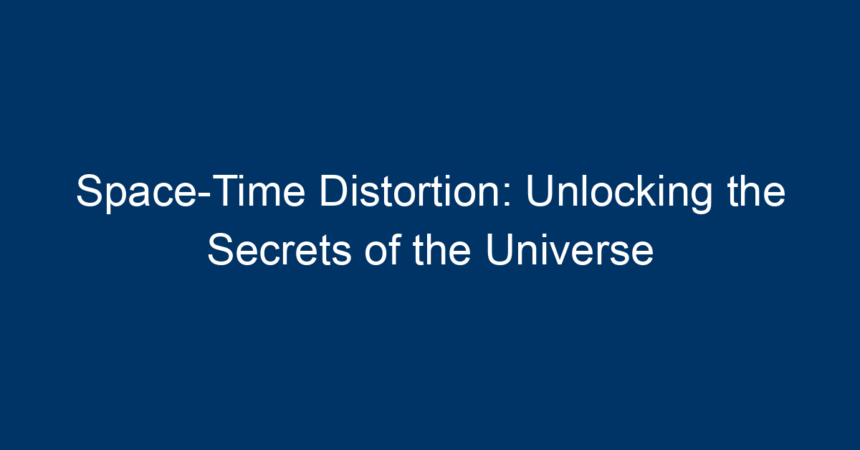The universe is a complex tapestry woven from the fabric of space-time, a concept that intertwines the dimensions of space with the flow of time. Among its many enigmas, space-time distortion stands out as a riveting phenomenon that challenges our understanding of reality. This article will delve into the mysteries of space-time distortion, examining its implications on physics, our universe’s structure, and its potential applications.
What is Space-Time Distortion?
Before we dive deeper into the implications and applications of space-time distortion, it’s crucial to grasp what it actually means. At its core, space-time distortion refers to the alteration of the fabric of space and time caused by mass and energy. Think of it as the way gravity bends the space around massive objects. This phenomenon is central to Einstein’s theory of general relativity.
Understanding Einstein’s Theory of General Relativity
Einstein’s groundbreaking theories, particularly general relativity, fundamentally reshaped our understanding of gravity. According to this theory:
- Mass Curves Space-Time: Massive objects like planets and stars create a gravitational field that distorts the surrounding space-time.
- Time Dilation: The stronger the gravitational field, the slower time moves relative to an observer outside that field. This effect has been confirmed by numerous experiments, including those involving atomic clocks on airplanes.
This interaction between mass and the geometry of space-time lays the groundwork for understanding space-time distortion and its fascinating implications.
The Science Behind Space-Time Distortion
Gravitational Lensing
One of the most profound demonstrations of space-time distortion is gravitational lensing. When light from distant stars or galaxies passes near a massive object, such as a black hole, the light bends. This bending magnifies and distorts the image of the distant objects.
Key Facts about Gravitational Lensing
- Discovery: First observed during a solar eclipse in 1919, confirming Einstein’s predictions.
- Applications: Astrophysicists use gravitational lensing to study dark matter and the energy composition of the universe.
Quantum Mechanics
Space-time distortion is not limited to large cosmic phenomena. Quantum mechanics introduces interesting concepts that may also manipulate space and time on a subatomic level. The interplay between quantum particles can lead to conditions where our conventional understanding of space-time is challenged.
Space-Time Distortion and Black Holes
Black holes are one of the most extreme examples of space-time distortion. Their immense gravitational pull warps space-time to such an extent that not even light can escape their grip. This creates a ‘shadow’ known as the event horizon.
The Mystery of Event Horizons
- Event Horizon: The boundary beyond which nothing can escape.
- Singularity: The core of a black hole where density becomes infinite and space-time curves infinitely.
Understanding black holes provides valuable insights into space-time distortion, demonstrating how mass affects the geometry of the universe in extreme conditions.
The Interplay of Space-Time Distortion and Time Travel
Is Time Travel Possible?
The concept of time travel has long captivated our imaginations, and space-time distortion plays a critical role in these discussions. While theoretical physics suggests methods like wormholes and warp drives, the practical application remains highly speculative.
Wormholes
Wormholes, or Einstein-Rosen bridges, are hypothetical tunnels through space-time that could act as shortcuts between two distant points in the universe. If stable wormholes could be created, they might allow for time travel, provided they don’t collapse under the forces acting upon them.
Warp Drives
Similarly, warp drives propose a way to bend space-time around a spacecraft, potentially allowing for faster-than-light travel. While the concept remains theoretical, advancements in physics are inching us closer to understanding such possibilities.
Space-Time Distortion in Popular Culture
The ideas surrounding space-time distortion have permeated popular culture. Films like "Interstellar" and series like "Doctor Who" offer imaginative interpretations of these complex concepts, often using them to drive thrilling narratives. While these representations can often be far from scientific truth, they ignite public interest and intrigue in physics, motivating a deeper exploration of the universe.
The Future of Space-Time Distortion Research
As technology advances, so too does our ability to observe and study space-time distortion. Instruments like gravitational wave detectors, such as LIGO, have opened new avenues for understanding phenomena associated with high-energy cosmic events.
Actionable Insights for Aspiring Researchers
- Stay Informed: Keep up with the latest research in astrophysics, quantum mechanics, and general relativity. Journals like "The Astrophysical Journal" publish groundbreaking studies that can enhance your understanding.
- Engage with the Community: Attend conferences, webinars, and workshops that focus on space-time research. Networking with professionals can provide insights and inspire your own theories.
- Explore Educational Resources: Numerous online platforms offer courses on astrophysics and theoretical physics, allowing you to deepen your understanding of space-time distortion.
Conclusion
Space-time distortion is a captivating subject that not only enriches our understanding of the universe but also challenges the boundaries of physics. From gravitational lensing to the enigma of black holes, the secrets hidden within space-time offer an endless realm for exploration. As researchers continue to unlock more mysteries, we are reminded of the incredible complexity of the universe we inhabit.
The journey into the depths of space-time distortion is just beginning. Whether you’re a seasoned physicist or a curious observer, the exploration of space-time offers a captivating perspective on our place in the cosmos. Engage with the science, question the mysteries, and who knows what truths you might uncover about the fabric of reality itself.
Keywords Recap
To summarize, the primary keyword "space-time distortion" and related keywords are woven throughout this article, ensuring a comprehensive understanding of this complex concept. As we delve deeper into these scientific realms, we open the door to untold possibilities that could redefine our understanding of the universe.




